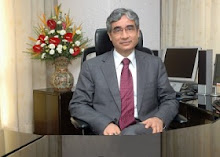Dr. Sanduk Ruit (above left), estimates sight has been restored to about 3 or 4 million people through his method. Most of them live in the developing world, where a loss of vision can be worse than death because of the added burden thrust on families already drowning in hardship
HETAUDA (Nepal) - RAJ KALIYA Dhanuk sits on a wooden bench, barefoot, with a tattered sari covering thin arms as rough as bark. Thick clear tears bleed from her eyes, milky saucers that stare at nothing.
For nearly a year, cataracts have clouded out all sight from the 70-year-old grandmother's world. With no money, she assumed she'd die alone in darkness. But now she waits quietly outside the operating room for her turn to meet Nepal's God of Sight.
'I am desperate. If only I could see my family again,' she whispers in her native tongue. 'I feel so bad when I hear the baby cry because I can't help him. I want to pick him up.' Dhanuk and more than 500 others - most of whom have never seen a doctor before - have traveled for days by bicycle, motorbike, bus and even on their relatives' backs to reach Dr. Sanduk Ruit's mobile eye camp.
Each hopes for the miracle promised in radio ads by the Nepalese master surgeon: He is able to poke, slice and pull the grape-like jelly masses out of an eye, then refill it with a tiny artificial lens, in about five minutes. Free of charge. It's an assembly-line approach to curing blindness that's possible thanks to a simple surgical technique Ruit pioneered, allowing cataracts to be removed safely without stitches through two small incisions. Once condemned by the international medical community as unthinkable and reckless, this mass surgery 'in the bush' started spreading from Nepal to poor countries worldwide nearly two decades ago.
Thousands of doctors - from North Korea to Nicaragua to Nigeria - have since been trained to train others, with the hope of slowly lessening the leading cause of blindness that affects 18 million people worldwide. And later this year, US military surgeons will train under Ruit for the first time. Ruit estimates sight has been restored to about 3 or 4 million people through his method. Most of them live in the developing world, where a loss of vision can be worse than death because of the added burden thrust on families already drowning in hardship. 'You realize there are drops which make an ocean,' says Ruit, 55, an ethnic Sherpa who grew up poor in a remote mountain village on the border near Tibet. 'They're such wonderful cases that make you fully convinced of the power of the work.'
No one pays for anything, and the entire cost is about US$25 per surgery. That's US$12,750 for all 510 patients, equal to only about three or four surgeries in the US. Costs are kept down by keeping things simple. Using lenses manufactured at Ruit's Tilganga Eye Center in Katmandu, these remote eye camps are sustained through donations and fees from more affluent Nepalese patients seeking surgery. But it's not the technique or the lenses or the hospital Ruit is most proud of. It's the ripple effect from all of the doctors who come to Nepal to train under him and then go on to teach others who repeat the cycle.
AP






No comments:
Post a Comment